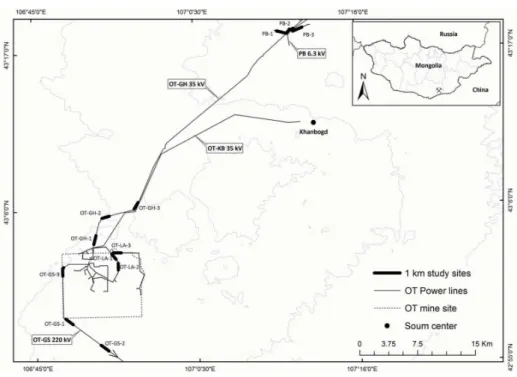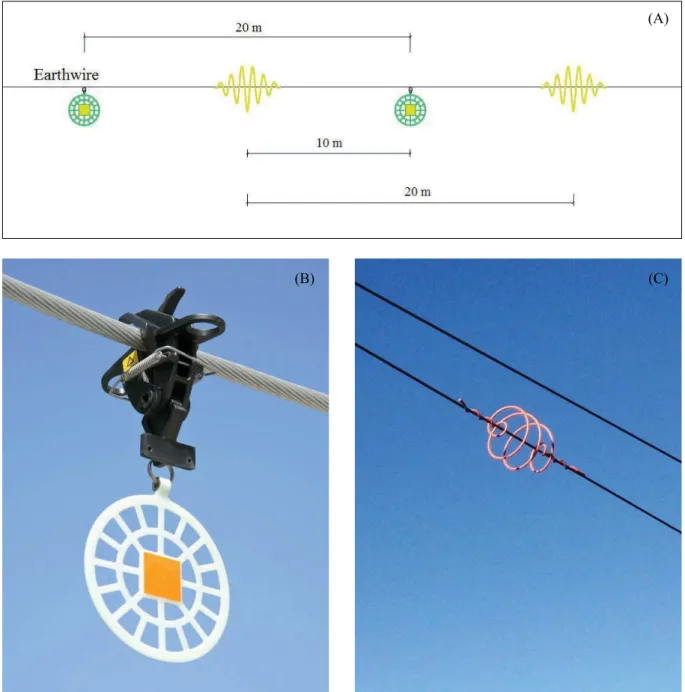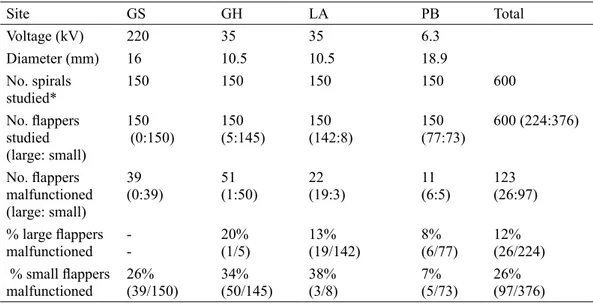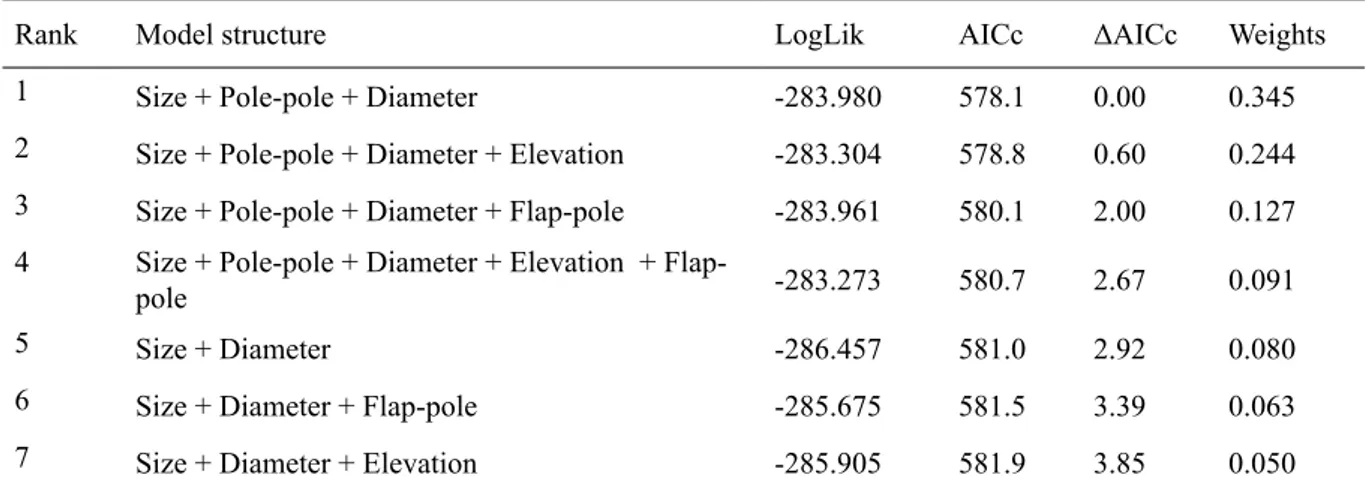13 http://mjbs.num.edu.mn
http://biotaxa.org./mjbs Volume 14(1-2), 2016
Mongolian Journal of Biological
Sciences
ISSN 2225-4994 (online edition)
MJBS
Original Ar• cle
http://dx.doi.org/10.22353/mjbs.2016.14.02
Key words: Bird fl ight diverter, Gobi, malfunction, mitigation, powerline
Article information: Received: 26 Feb. 2016 Accepted: 04 Nov. 2016 Published online: 14 Nov. 2016
Correspondence: dashnyamb@ot.mn Cite this paper as:
Malfunction Rates of Bird Flight Diverters on
Powerlines in the Mongolian Gobi
Batsuuri Dashnyam
1*, Tsolmonjav Purevsuren
1, Saruul Amarsaikhan
1, Dandarmaa
Bataa
1, Bayarbaatar Buuveibaatar
2and Guy Dutson
3,41Health, Safety and Environment Department, Oyu Tolgoi LLC, Chingis Avenue 15, Ulaanbaatar 14240, Mongolia
2Mongolia Program, Wildlife Conservation Society, Ulaanbaatar, Mongolia 3The Biodiversity Consultancy, 3E King’s Parade, Cambridge, CB2 1SJ, United Kingdom 4School of Life and Environmental Sciences, Deakin University, Waurn Ponds, Vic 3216, Australia
Abstract
The Oyu Tolgoi (OT) project, one of the world’s largest copper and gold mines, is located in Gobi Desert of Mongolia. To help meet its target of Net Positive Impact on key biodiversity features such as the Houbara bustard (Chlamydotis undulata) the OT installed bird fl ight diverters (BFDs include spiral and fl apper devices) to its power transmission lines to reduce the risk of birds hitting the wires. Despite the many studies demonstrating that BFDs reduce collision rates, we could fi nd no published information on malfunction rates of BFDs. In January 2013, we surveyed the physical function of 1,200 BFDs (e.g. 600 fl appers and 600 spirals) in three sample areas on each of four lines of varying voltage and structure. Of the 600 fl appers examined, 123 had malfunctioned within nine months of installation, while the malfunction rate of the 600 spirals studied was zero. Using a Generalized Linear Mixed Model, we found that the rate of fl apper malfunction increased with decreasing fl apper size and power line diameter. Further, the fl apper malfunction rate increased as the distance between poles increased. The cost of replacing malfunctioning BFDs is very high as there are serious health and safety constraints related to working with live wires. Factors aff ecting diverter malfunctioning need to be considered for future powerline projects and our information can serve as basis for developing national standards or regulations for powerline mitigation in Mongolia.
Dashnyam,B., Purevsuren, Ts., Amarsaikhan, S., Bataa, D., Buuveibaatar, B. & Dutson, G. 2016. Malfunction rates of bird fl ight diverters on powerlines in the Mongolian Gobi. Mong. J. Biol. Sci., 14(1-2): 13-20.
Introduction
The Oyu Tolgoi (OT) project, one of the world’s largest copper and gold mines, is located in Khanbogd soum in Umnugobi province of Mongolia. In 2012, OT constructed a 96 km 220 kV power transmission line between the OT mine site and the Gashuun Sukhait (GS) check point at the Mongolia-China border. OT has also constructed a 35.5 km 35 kV transmission
line from the mine site to Khanbogd town, a 68 km 35 kV line to the borefi eld at Gunii Hooloi (GH), shorter 35 kV lines within the mine site (LA), and 6.3 kV distribution lines to individual production bores (PB) (Figure 1).
Asiatic wild ass (khulan in Mongolian; Equus hemionus), Goitered gazelle (or Black-tailed gazelle; Gazella subgutturosa) and Houbara bustard (Chlamydotis undulata) (TBC & FFI, 2012). Some of the OT powelines cross the Galba Gobi Important Bird Area that supports a globally important population of Houbara bustard (Batbayar & Natsagdorj, 2009; Batbayar et al., 2011). The OT Environmental and Social Impact Assessment predicted that collisions with project power lines would signifi cantly impact some bird species including the Houbara bustard, as they are particularly susceptible to colliding with power lines (Martin & Shaw, 2010).
Powerlines are estimated to kill 12-64 million birds each year in the USA (Loss et al., 2014) and 2-26 million in Canada (Rioux et al., 2013). Marking power lines with bird fl ight diverters (BFDs) to increase the visibility of these lines to fl ying birds has been shown to reduce mortalities by 55–94% (Barrientos et al., 2011). Common BFDs include spiral and fl apper devices: Polyvinyl chloride (PVC) spirals, alone, have been shown to reduce bird collisions by up to 81% (Janss & Ferrer, 1998), while fl appers on their own have been shown to reduce collisions by 60-63% (Brown & Drewien, 1995; Yee, 2008), and fl appers added to spirals have been shown to reduce collisions by an additional 52% (Anderson, 2002).
During 2013, there were 118 recorded
incidents of birds colliding with the OT-GS power transmission line, despite the installation of BFDs. However, a signifi cant proportion of fl appers appeared to malfunction soon after the installation. There is no published information available on malfunction of BFDs. This study aimed to identify causes of BFD malfunction, and to recommend improved operating procedures.
Study area
The OT study area is located in Khanbogd soum in Umnugobi province, approximately 80 km north of the Mongolia-China border and 550 km south of Ulaanbaatar (Figure 1). The climate is strongly continental with daily means reaching 40oC in summer and dropping to -35oC
in winter. The long-term average (1976–2014) wind speed around OT is 4.2 m.sec-1, with the strongest wind recorded being 49.9 m.sec-1 in June 2007 (Oyu Tolgoi General Site Conditions report, 2015). Elevations in the study area range from 600-1350 m. Vegetation is sparse and in large parts dominated by drought adapted central Asian desert species, particularly Stipa gobica, Allium mongolicum, Iljina regelii, and Anabasis brevifolia (von Wehrden et al., 2009). To date, 225 species of birds have been recorded in and around the OT mine site. Several globally and regionally threatened species found at the site include endangered Dalmatian pelican
(Pelecanus crispus), Relict gull (Larus relictus) and Great bustard (Otis tarda) and, in addition to these species, Saker falcon (Falco cherrug), Houbara bustard (Chlamydotis undulata), Short-toed snake eagle (Circaetus gallicus) and Amur falcon (Falco amurensis) do also occur (Purevsuren et al., 2013).
Materials and Methods
To mitigate the impacts of power lines, BFDs were installed in April and May 2012 at 10 m intervals along the OT-GS power transmission line, alternating between BirdMark™, hereafter
called ‘fl appers’ (Clydesdale Ltd, Kempston, Bedford, United Kingdom), and Swan-Flight Diverter™, hereafter called ‘spirals’ (Ampirical Solution LLC, Mandeville, Louisiana State, USA) (Figure 2A). Two sizes of fl apper were installed – small fl appers were designed to fi t wires of 6-16 mm diameter and large fl appers to fi t wires of 16-70 mm diameter. This is the fi rst time that BFDs have been installed in Mongolia. Flappers were designed to rotate, fl ap, and whistle in response to wind and wire movement, to refl ect light, and to glow for up to 10 hours after the sun has set (Figure 2B). Spirals were designed to be highly visible but immobile
Figure 2. Schematic of the installation pattern of Bird Flight Diverters (A) and photos of a fl apper (B) and a spiral (C) installed on power line in Southern Gobi, Mongolia.
(A)
(Figure 2C). Both types of BFDs were installed on the highest wire because the majority of collisions are with these earth wires, which are higher, thinner, and in a single row (e.g. APLIC, 2006).
In January 2013, we surveyed the physical function of 600 fl appers and 600 spirals in three sample areas, each containing 100 BFDs (e.g. 50 fl appers and 50 spirals), on each of four lines: the OT – GS 220 kV transmission power line (GS), OT – GH 35 kV transmission power line (GH), 35 kV power lines inside the OT site area (LA) and 6.3 kV power distribution lines (PB) (Figure 1). Each sample area was spaced 1 km apart on the GS and GH lines, but the samples were continuous on the shorter LA and PB lines. We walked along the sample areas, and observed each fl apper with 10x42 binoculars to determine whether it was properly working (e.g., rotating and fl apping), and photographed it with a Canon 7D camera and 100-400 mm lens. We considered fl appers to have malfunctioned when stuck in the up position and immobile, or when fallen. We also considered spirals to have malfunctioned when fallen. To explore potential causes of malfunction, we measured the distance between adjacent pylons or poles, the distance from each BFD to the nearest pylon or pole, and the height of each BFD from the ground using a Swarovski 10 x 30 laser rangefi nder. We also recorded the elevation (above sea level) of each BFD using a Global Positioning System.
We used General Linear Mixed Models (GLMMs) to model the combined eff ects of the six variables on physical function of fl appers: the distance between adjacent poles (Pole-pole), the distance from each BFD to the nearest pole (Flap-pole), the height of each BFD from the ground (Height), elevation (Elevation), fl apper size (Size), and the wire diameter (Diameter). We fi tted GLMMs with a binomial error distribution to the data using the ‘lme4’ library in R (R Development Core Team, 2008). We excluded Height from the model because it was positively correlated with Flap-pole (rho = 0.93) and Elevation (rho = 0.72). We scaled each continuous predictor variables using ‘z-score’ standardization to have a mean of 0 and a standard deviation of 1. We incorporated site (e.g. GS, GH, LA, and PB) as a random factor in the analysis to account for potential diff erences in topography. We ran all possible model subsets of the fi ve variables and ranked them using the Akaike Information Criterion (AICc) for small sample sizes. The fi nal set of models was the most parsimonious based on ΔAICc < 4 (Anderson, 2008). Models with a ≤ 2 AICc unit diff erence were considered equivalent (Burnham & Anderson, 2002). To quantify the infl uence of each covariate on diverter function, we used model-averaging techniques to obtain parameter estimates, unconditional standard errors and the relative support of each variable (Burnham & Anderson, 2002) within the ‘MuMIn’ library in
Site GS GH LA PB Total Voltage (kV) 220 35 35 6.3
Diameter (mm) 16 10.5 10.5 18.9 No. spirals
studied*
150 150 150 150 600 No. fl appers
studied (large: small) 150 (0:150) 150 (5:145) 150 (142:8) 150 (77:73) 600 (224:376)
No. fl appers malfunctioned (large: small) 39 (0:39) 51 (1:50) 22 (19:3) 11 (6:5) 123 (26:97) % large fl appers
malfunctioned -20% (1/5) 13% (19/142) 8% (6/77) 12% (26/224) % small fl appers
malfunctioned 26% (39/150) 34% (50/145) 38% (3/8) 7% (5/73) 26% (97/376)
R (Barton, 2012). In addition, we calculated the model AICc weights to measure the likelihood of a candidate model being the best among the set of fi tted models. We acknowledge that these modelling approaches are post-hoc analyses and no manipulations or fi eld experiments was made.
Results
We surveyed a total of 600 fl appers (376 small and 224 large) in four sites, of which 123 had malfunctioned (97 small and 26 large; Table 1). Whereas, the malfunction rate of 600 spirals examined in the four power transmission lines of varying voltage and diameter was zero. The
parameter estimates of full model indicated strong infl uence of covariates such as Size, Diameter, and Pole-pole on the malfunction rate of fl appers (Table 2). The probability of the fl apper malfunction increased as the size of the device (β = -1.134, SE = 0.304) and the diameter of the wire decreased (β = -0.727, SE = 0.270), while the fl apper malfunction rate increased as the distance between poles increased (β = 0.482, SE = 0.233; Table 2). However, Elevation and Flap-pole appeared as weak predictors given
that the estimated coeffi cients of these covariates
overlapped zero (Table 2). The estimated variance of the random eff ect (e.g. site) was nearly zero, suggesting site-specifi c diff erences
Coeffi cients Estimate SE Z value P value Variable
importance
Intercept -1.103 0.141 -7.847 <0.001
Size -1.134 0.304 -3.730 <0.001 1.00
Diameter -0.727 0.270 -2.694 <0.005 1.00
Pole-pole 0.482 0.233 2.066 <0.05 0.81
Elevation -0.402 0.357 -1.124 NS 0.39
Flap-pole -0.033 0.131 -0.250 NS 0.28
Table 2. Model averaged-parameter estimates of the full model for determining physical function of bird fl ight diverters installed on powerlines in Southern Gobi, Mongolia. All variables were scaled using ‘z-score’ standardization. Coeffi cient estimates, standard errors and relative importance of variables were obtained based on the Akaike Information Criterion for small samples sizes (AICc) statistic following Burnham & Anderson (2002) model averaging procedures. NS – not signifi cant.
Table 3. Model selection results for estimation of factors aff ecting malfunction rate of bird fl ight diverters installed on powerlines in the Southern Gobi, Mongolia. We present results of the top 7 ranked models that have AICc weight > 0.05.
Rank Model structure LogLik AICc ΔAICc Weights
1 Size + Pole-pole + Diameter -283.980 578.1 0.00 0.345
2 Size + Pole-pole + Diameter + Elevation -283.304 578.8 0.60 0.244
3 Size + Pole-pole + Diameter + Flap-pole -283.961 580.1 2.00 0.127
4 Size + Pole-pole + Diameter + Elevation +
Flap-pole -283.273 580.7 2.67 0.091
5 Size + Diameter -286.457 581.0 2.92 0.080
6 Size + Diameter + Flap-pole -285.675 581.5 3.39 0.063
7 Size + Diameter + Elevation -285.905 581.9 3.85 0.050
in malfunction rate of the fl appers was negligible. When running all possible subset models, the model of fl apper malfunction rates that best fi t our data (minimum AICc) contained covariates of Size, Diameter, and Pole-pole (Table 3). The inclusion of the Elevation into the best model produced the second ranked competitive model (AICc weight 24%). These parameters accounted for 59% of the AICc weight among the seven models (Table 3). We found slight changes in the parameter estimates from the top ranked two competitive models, relative to the parameter estimates from the full model (Table 2 and 4). Based on the hierarchical partitioning approach, the relative importance of Diameter, Size, and Pole-pole were greater than those of Elevation and Flap-pole for explaining physical function of fl apper performance (Table 2).
Discussion
This is the fi rst eff ort to examine factors infl uencing performance of BFDs in Mongolia, and the fi rst published study we could fi nd to evaluate BFD malfunction rates. We found that 123 of 600 fl appers had malfunctioned within nine months of installation. During subsequent monitoring we found that the malfunction rate increased with time. In contrast, none of 600 spirals studied along the four power transmission lines of varying voltage and diameter was malfunctioned. This is probably due to the spirals were designed and installed to be immobile. When modelled, we found physical function of fl apper failed as the size of the device and the diameter of the wire decreased, while the fl apper malfunction rate increased as the distance between poles increased. However, elevation and the distance from each fl apper to the nearest pole appeared as weak predictors infl uencing malfunction of fl appers.
The causes of these malfunctions of the
fl appers are not known but likely related to the design of the grounder that connects the fl apper to the wire and/or to the wire ring that allows the fl appers to rotate and fl ap with wind and wire movement. Some small fl appers (designed for 35 kV lines) might have been incorrectly installed on unsuitably large 220 kV lines. High wind speeds might have caused swinging and twisting of wires which locked fl appers into fi xed positions, and/or wore through the wire rings, and/or dislodged or damaged the grounders. Additionally, sub-zero temperatures and encrusted ice might have damaged the wire rings, grounders or other parts of the fl appers.
The cost of replacing malfunctioning BFDs is now very high because of health and safety constraints related to working with live wires. There are two ‘lessons learned’ arising from this research as the fi rst eff ort to mitigate the impacts on birds of power lines in Mongolia. First, this study acts as a cautionary warning to the “national power transmission grid” state owned company, other mining companies, and power line installers about the high rate of BFD malfunction (e.g. fl appers), possibly related to the weather conditions of the South Gobi. Secondly, our experience with the installation of BFDs should be incorporated into national standards, specifi cally MNS 2919: 2003, MNS 5350: 2003 (Mongolian National Standard, 2004 and 2016), and power construction and regulations for the mitigation of powerline impacts on birds (Ministry of Infrastructure of Mongolia, 2004).
Electric power supply networks in Mongolia are responsible for causing bird mortality, especially raptors, through electrocution and collision (Amartuvshin & Gombobaatar 2012). We recommend that future power lines installed in Mongolia in areas of high risk to threatened birds, such as bustards, include spirals as BFDs because their malfunction rate was zero. Flappers
Table 4. Model-averaged estimates and standard errors (β ± SE) of the top ranked 2 competitive models (e.g.
ΔAICc value is within 2 AICc) for determining physical function of bird fl ight diverters installed on powerlines in Southern Gobi, Mongolia. Signifi cance code: ‘***’ 0.001; ‘**’ 0.01; ‘*’ 0.05; ‘.’ 0.1.
Rank Intercept Size Pole-pole Diameter Elevation
1 -1.160 ± 0.133*** -0.962 ± 0.264*** 0.266 ± 0.120* -0.462 ± 0.122***
should be installed on an experimental basis to
investigate their durability and their effi cacy as
BFDs. More importantly, where possible, projects and developers should design-out the need for power lines, or minimise their length and locate them along routes of minimum risk to threatened birds. Lower-risk designs of pylons, poles and wire arrays should always be chosen to permanently reduce the risk to both threatened birds and the installer’s reputation. This is particularly topical in the South Gobi, as new powerlines are being constructed in areas supporting Houbara bustards and other species of conservation concern.
Acknowledgements
Oyu Tolgoi LLC provided support for this study. We thank Dennis Hosack, Jez Bird, John Pilgrim, David Wilson, and Oyun-Erdene Tseesuren for their advice, comments, and assistance on the survey.
References
Amartuvshin, P. & Gombobaatar, S. 2012. The assessment of high risk utility lines and conservation of globally threatened pole
nesting steppe raptors in Mongolia. Ornis
Mongolica, 1: 2–12.
Anderson, D. R. 2008. Model based inference
in the life sciences: a primer on evidence. Springer, New York.
APLIC (Avian Power Line Interaction
Committee) 2006. Suggested practices for
avian protection on power lines: state of the art in 2006. Edison Electric Institute, Washington, D.C. and the California Energy Commission, Sacramento, California.
Barton, K. 2012. MuMIn: Multi-model inference.
R package version 1.7.11. Downloaded from http://CRAN.R-project.org/package=MuMIn. Batbayar, N. & Natsagdorj, T. (eds.) 2009.
Directory of Important Bird Areas in Mongolia: Key Sites for Conservation. Wildlife Science and Conservation Center of Mongolia, Ulaanbaatar and BirdLife International, Cambridge, U.K.
Batbayar, N., Batsukh, B., Stacey, J. &
Bräunlich, A. 2011. Key endangered species
in Galba Gobi: status and provisional impact assessments of regional development scenarios. East Asia and Pacifi c Region
Sustainable Development Department, World Bank, Washington D.C.
Barrientos, R., Alonso, J. C., Ponce, C. & Palacín, C. 2011. Meta-analysis of the eff ectiveness of marked wire in reducing
avian collisions with power lines.
Conservation Biology, 25: 893–903.
Brown W. M. & Drewien R. C. 1995. Evaluation of two power line markers to reduce crane
and waterfowl collision mortality. Wildlife
Society Bulletin, 23: 217–22.
Burhnam, K. P., & Anderson, D. R. 2002. Model
Selection and Multi-model inference: A practical Information-theoretic approach. 2nd ed. Spring-Verlag, New York.
Janss, G. F. E. & Ferrer, M. 1998. Rate of bird collision with power lines: eff ects of conductor-marking and static wire-marking.
Journal of Field Ornithology, 69: 8–17. Loss, S.R., Will, T. & Marra, P.P. 2014. Refi ning
Estimates of Bird Collision and Electrocution Mortality at Power Lines in the United States.
PLoS ONE, 9(7): e101565.
Martin, G. R. & Shaw, J. M. 2010. Bird collisions with power lines: Malfunctioning to
see the way ahead? Biological Conservation,
143: 2695-2702.
Ministry of Infrastructure of Mongolia, 2004. Regulation of Power Construction, BD43-101-03.
Mongolian National Standard, 2004. Power
energy and electrocution. Terms and
defi nitions, MNS 2919: 2003.
Mongolian National Standard, 2016.
Requirement for building 0.4-22 kV power line, MNS 6518: 2015.
Oyu Tolgoi General Site Conditions report, 2015. Document No. DC-10-001, Revision 8.
Purevsuren, T., Dashnyam, B., Dorjderem, S., Bataa, D., & Amarsaikhan, S. 2013. Rare
birds of Oyu Tolgoi project area. Ornis
Mongolica, 2: 47-56.
Rioux, S., Savard, J.P.L. & Gerick, A.A. 2013. Avian mortalities due to transmission line collisions: a review of current estimates and fi eld methods with an emphasis on applications to the Canadian electric network.
Avian Conservation and Ecology, 8 (2): 7.
R Development Core Team 2008. R: a language
TBC & FFI 2012. ESIA Appendix 4: Biodiversity Off sets Strategy for the Oyu Tolgoi Project. Unpublished Draft Report of The Biodiversity Consultancy Ltd and Fauna & Flora
International.
von Wehrden, H., Wesche, K. & Miehe, G. 2009. Plant communities of the southern Mongolian Gobi. Phytocoenologia, 39: 1-47.



